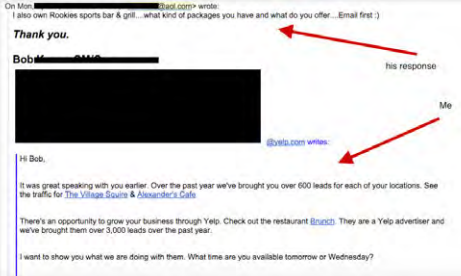9.9: Estudio de caso - Yelp
- Page ID
- 67893
Resumen de una línea
Una vendedora de Yelp triplicó su tasa de respuesta de marketing por correo electrónico B2B personalizando y humanizando la copia del correo electrónico.
El reto
Las plantillas de correo electrónico de ventas de Yelp estaban secas y poco atractivas, sin considerar a la audiencia a la que estaban escribiendo y no incluían ninguna consideración de características vs beneficios. Esto provocó una desconexión entre la marca y su público. Los correos electrónicos hicieron sonar la fuerza de ventas, “Como un montón de robots... sin personalidad” (Medhora, 2015)
La solución
Un vendedor de Yelp probó varios correos electrónicos más personalizados y se le ocurrió una fórmula que aumentó considerablemente las tasas de respuesta. Ella se centró en demostrar que era una persona real y en construir un sentido de urgencia, y su fórmula se veía así:
Característica + Beneficio + Valor + Factor Humano = Correo electrónico con más probabilidades de obtener una respuesta
Entonces, por ejemplo, para la función, enlazaría a las páginas de Yelp de una empresa. El beneficio sería una descripción de cómo el negocio puede crecer a través de Yelp. El valor sería indicar cuántos leads había encontrado el negocio a través de Yelp, y el factor humano involucraba líneas de asunto casuales y uso de emojis. La línea de asunto para el correo electrónico a continuación fue “Re: Yelp Email Per Your Request — A Response would be appreciated ☺.

El vendedor realizó algunos experimentos para medir las tasas de éxito de los correos electrónicos personalizados contra los correos electrónicos de plantilla de Yelp, agregó algunos factores importantes a considerar: cómo la copia atrajo la atención, encendió el interés y el deseo, y alentó la acción, y luego se aseguró de que el correo electrónico también fuera interesante. También probó varios titulares, o líneas de asunto, para ver cuáles tenían las mejores tasas de respuesta.
Los resultados
- Su tasa de respuesta subió de 3.33% a 11.43% (¡aunque algunas de las respuestas fueran negativas!)
- ¡Aprendió algunas lecciones importantes sobre cómo personalizar tu copia, pensar en características vs. beneficios y escribir para una audiencia de uno puede mejorar las respuestas!


